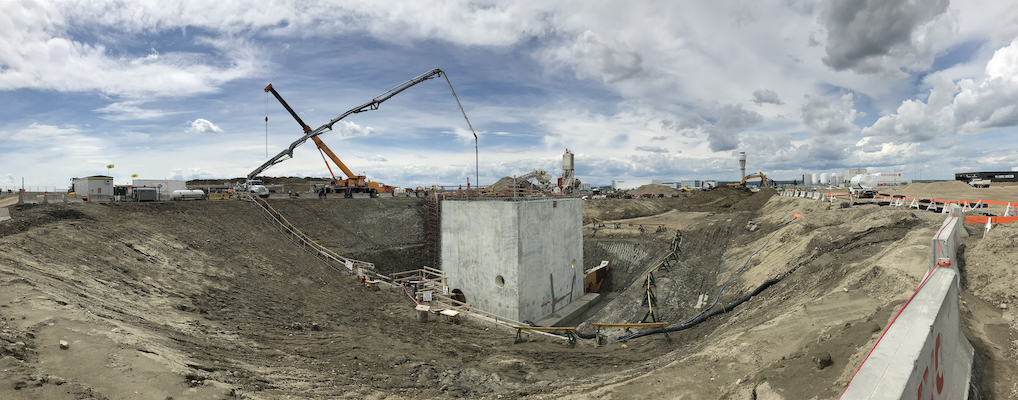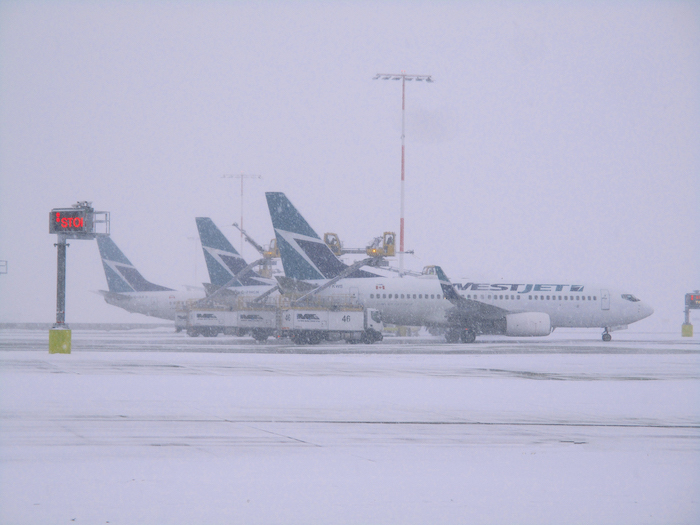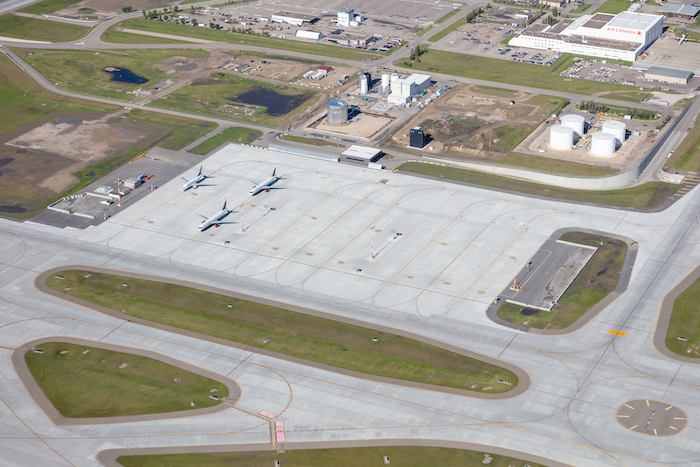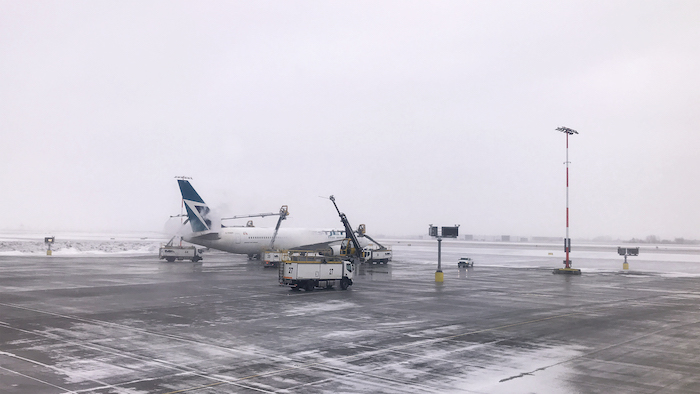
In-Depth
2022 #CCEawards Showcase: Calgary International Airport East Deicing Apron
November 4, 2022
By
Canadian Consulting Engineer

Category: Transportation
Schreyer Award and Award of Excellence Winner: Stantec
In 2018, WestJet and Air Canada indicated to the Calgary Airport Authority an immediate need for a centralized deicing facility at Calgary International Airport (YYC), which the authority operates and Transport Canada owns. Due to growing demands of air traffic and WestJet’s then-recent purchase of four Boeing 787 Dreamliner wide-body aircrafts, existing at-gate deicing operations—which could take up to 40 minutes—were no longer viable for keeping the airport running efficiently and without delays during peak hours.
Recognizing this need, the Calgary Airport Authority engaged Stantec’s aviation engineering team to design a new east deicing apron (EDA) with a diversion structure to treat glycol runoff. This project successfully reduced taxi times (i.e. total period for an aircraft’s movement on the ground) from 40 minutes to an average of 17 minutes, improved the passenger experience, reinforced YYC’s environmental policies and stewardship and maintained consistent glycol containment.
As a result, the EDA enables YYC to be self-sufficient in recycling its spent glycol and removes the chemical treatment burden from Calgary’s municipal government.
Custom techniques and designs
The EDA project comprises approximately 11 hectares of airfield pavement, more than 1,000 m of specialized stormwater drainage infrastructure, the new apron covering an area of approximately 110,000 m2 south of the airport’s new terminal and an underground diversion structure that is more than 10 m deep and redirects the apron’s deicing glycol runoff for treatment.
Two key points of innovation for this project stemmed from Stantec’s use of Autodesk’s Civil 3D engineering design and documentation software, which reduced the design effort by 200%, and from the firm’s stormwater modelling design, which reduced construction costs by more than $300,000.
The design of the EDA commenced in October 2018, with the target to open by winter 2019. The apron consists of three composite deicing pads, which can accommodate up to three Dreamliners or six Boeing 737 aircrafts at the same time.
Stantec used an advanced Civil 3D technique that involved replicating a single grading design across all of the composite pads, while the grading design was undertaken with dual-lane concrete slipform pavers in mind, to minimize construction co-ordination. If the design required any alteration, only one pad would need to be updated and the rest of the apron grading would be updated automatically. As a result of this technique, more than 110,000 m2 of concrete apron was completed within two weeks.
Stantec also developed a three-dimensional (3-D) model of the 12 x 12 x 10-m diversion structure—similar in size to a three-storey tall building—and invited the project team to walk through the design in virtual reality (VR). The model included all process piping and electrical conduit connections around the diversion structure, the nearby control building and the proposed excavation limit to build the structure. This strategy not only allowed the project team to visualize the size and details of the diversion structure, but also inspired productive discussions regarding its constructability.
Another point of innovation, as mentioned earlier, was in stormwater modelling, designed for both stormwater conveyance and the glycol recycling system.
Specialized engineers undertook modelling based on historical intensity-duration-frequency (IDF) curves to predict the required stormwater pipe sizing for the conveyance system and designed it accordingly, to provide adequate hydraulic performance based on the return period (i.e. average estimated recurrence interval) of a stormwater event.

Open excavation had to accommodate a diversion structure roughly the size of a three-storey tall building. Photo courtesy Stantec.
When reviewing historical precipitation data for the deicing season from Environment Canada’s records, the team overlaid that information with the historically applied spent aircraft deicing fluid (ADF) volumes, so as to optimally size the EDA’s recycling piping design.
This analysis was then transferred into a design tailored specifically for the EDA, which reduced the cost of the piping system compared to a design based on a 100-year storm event. By using parts of the diversion structure’s cells for storage, the pipe sizes were reduced upstream of that structure, which is what saved more than $300,000 in construction costs and significantly reduced the material procurement lead time as often seen with large pipe sizes.
At the heart of the deicing facility’s recovery system is the diversion structure, which consolidates incoming contaminated stormwater from the deicing operation, then ‘intelligently’ diverts the runoff for recycling, treatment or discharge, depending on its glycol concentration. This multi-cell, intricate structure, designed specifically for YYC, contains two 750-mm actuator valves and a sampling system that helps direct the contaminated stormwater accurately to its respective compartments. Clean stormwater is discharged through this structure into Nose Creek, reducing the overall strain on the recycling and treatment systems at YYC.
Tolerances and deadlines
Apron grading criteria for aircrafts call for very tight tolerances, ideally between 0.5 and 1.0%. If the grade is too flat, then it will not drain; if it is too steep, then the aircraft will exhaust too much fuel to maneuver.
For YYC’s EDA, this tolerance limit was coupled with a site-specific challenge, where grades are locked by all four sides of the facility. So, Stantec designed an apron that met all of the given criteria, but also built undisclosed tolerances into the grading design, to account for the contractor potentially missing the grading tolerance target. And this variance did indeed occur during construction, where a particular manhole was set slightly higher than designed, resulting in the pavement grade being flatter to tie to it. Since the design accounted for such issues, the apron with the flatter grade still drained adequately.
Another challenge, teetering on the side of impossibility, was a six-month construction deadline. The diversion structure required five months of construction, while the apron paving required three months of construction. To expedite the schedule, Stantec designed the grading with the paving plan in mind, while simultaneously working with the rest of the project team to plan that paving operation.
The paving started on the north side as soon as underground infrastructure was completed and while the diversion structure was still under construction on the south side. This approach enabled the construction of the diversion structure to start early to meet the deadline. The backfill of the structure was completed by the time the paving operation had reached the excavation limit of the structure.

The project team reviewed historical precipitation data for the deicing season from Environment Canada’s records. Photo courtesy Stantec.
Sustainability objectives
One of the main objectives of the EDA is to minimize the mixing of precipitation with glycol contamination. Ethelene glycol, a toxic, green chemical, makes up 88% of ADF’s composition. If ADF is allowed to mix with stormwater runoff and discharge into a nearby body of water, it depletes oxygen in the water stream, effectively killing living organisms. For this reason, Environment Canada’s mandate for the fluid’s discharge into nearby water bodies is limited to 100 parts per million, a concentration of 0.01%.
Stantec prepared five conceptual facility options for YYC and a consortium of airlines prior to commencing its full design process, so as to determine the most cost-effective and, more importantly, environmentally responsible solution. This process would ultimately reduce the would-be glycol-contaminated area from 55 hectares of the original apron to the 11 hectares of the EDA, achieving more than an 80% reduction in the catchment area.
With further sustainability in mind, the Stantec team’s concrete apron design also involved a technology that injects precise dosages of recycled carbon dioxide (CO2) into fresh concrete during batching and mixing, so as to reduce its carbon footprint without compromising the its performance. The recycled CO2 content came from industrial sites in Fort St. John, B.C., and was mineralized during the concrete mixing process.
With this carbon injection, the overall cement content within the concrete was lowered while still meeting the EDA’s strength requirements. The total carbon reduction achieved by this project was more than 259 tons, equivalent to 138 hectares of forest absorbing CO2 over the course of one year.
In addition, as the facility manager operates fully electric deicing vehicles, which further reduce the airport’s greenhouse gas (GHG) emissions, the project team prepared electric vehicle (EV) charging stations for 14 stalls.
Saving time and money
The Calgary Airport Authority’s objectives for the design included keeping the capital budget low and completing the project by the 2019/2020 deicing season. To help meet these objectives, Stantec engaged the future operators of the new facility during the design phase for their input. Subsequently, all design elements were chosen with consideration for ease of operation and maintenance (O&M), such that staff training could be minimized to save time in advance of the deicing season.
This philosophy of efficiency was carried beyond the proposed design, as the EDA also has the potential to be expanded and mirrored for added capacity in the future. Together, Stantec and the Calgary Airport Authority studied the surrounding area and purposefully placed the diversion structure in the middle of the ultimate apron buildout.

Three composite deicing pads can accommodate up to three Boeing 787 or six Boeing 737 aircrafts at the same time. Photo courtesy Stantec.
This arrangement means the grading design can be fully duplicated for future expansion and the stormwater conveyance system underneath the apron can be mirrored across the ultimate buildout. This ease of expansion will save a significant amount of design effort in the future, further reduce taxi time and improve the passenger experience.
Stantec’s strategic civil design methodology proved a significant success in maintaining the project’s scope, shortening its schedule and minimizing its budget, as demonstrated through the associated fees. The engineering fee for the civil design was only about 0.27% of the civil construction cost, while the overall consulting fee—including full-time construction—is only about 2% of the total capital budget for the project, far below industry standards. In this sense, the team provided unbeatable value.
Setting the road map
The project has been a tremendous operational, environmental, engineering and financial success. As a result of adding a state-of-the-art deicing facility, the airport has cut the average aircraft taxi time during the winter season from 40 minutes down to 17 minutes. The project has not only meant shorter deicing, taxi and at-gate times, but also enabled passengers to arrive at their destinations sooner and, for that matter, safer.
The deicing apron’s effective recovery system, coupled with on-site treatment and recycling facilities, means the airport can eliminate its reliance on Calgary’s municipal wastewater treatment plants (WWTPs) for the chemical oxygen demand (COD) burden. As a consequence, the city’s existing infrastructure and systems can serve more communities, without the need to expand them.
YYC’s EDA is Alberta’s largest centralized deicing facility. It solidifies the airport’s position as an environmentally responsible steward for the city, the province and the country. Throughout the project’s entire life cycle, Stantec’s engineering design was developed and implemented with the public in mind. Travellers benefit from the behind-the-scenes operations of this critical facility, which also sets a new standard for other airports across North America.
“The EDA is one of YYC’s most advanced and key infrastructure projects,” says Muhammad Kaleem, infrastructure civil engineer for the airport. “It sets the road map for the airport’s future growth by entertaining efficient deicing protocols and reducing taxi times for the aircrafts. This state-of-the-art facility, accomplished by Stantec and the Calgary Airport Authority’s in-house design teams, upholds Calgary’s unmatchable hospitality and the airport’s promise of delivering the best customer experience.”
Calgary International Airport East Deicing Apron, Calgary
Award-winning firm (prime consultant): Stantec, Calgary. (Joseph Chen, P.Eng.; Dave Crawford, P.Eng.; Taha Lotia, P.Eng.; Bryce Pasiuk, P.Eng.; Michael Magas, C.E.T, M.E; Chad Zettel, C.E.T; Stephen Lee, B.Eng., M.Sc., P.Eng.; Murray Miller, C.E.T; Kevin Travis; Al Leskow).
Owner: Calgary Airport Authority.
Other key players: Autodesk, PCL Construction, CarbonCure, Aéro Mag.
Print this page
